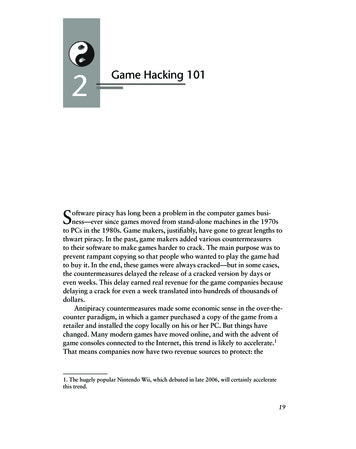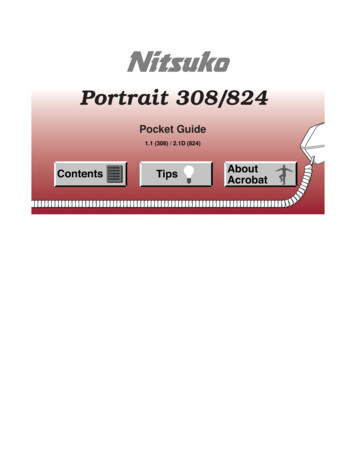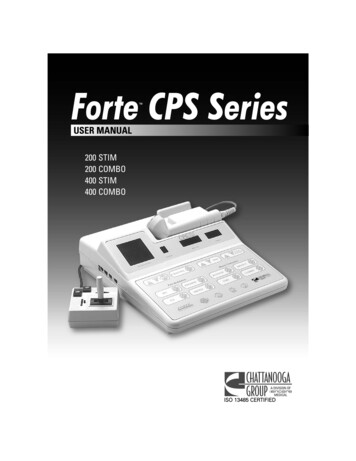
Transcription
6627ch02.qxd lb6/22/0727:31 AMPage 19Game Hacking 101Software piracy has long been a problem in the computer games business—ever since games moved from stand-alone machines in the 1970sto PCs in the 1980s. Game makers, justifiably, have gone to great lengths tothwart piracy. In the past, game makers added various countermeasuresto their software to make games harder to crack. The main purpose was toprevent rampant copying so that people who wanted to play the game hadto buy it. In the end, these games were always cracked—but in some cases,the countermeasures delayed the release of a cracked version by days oreven weeks. This delay earned real revenue for the game companies becausedelaying a crack for even a week translated into hundreds of thousands ofdollars.Antipiracy countermeasures made some economic sense in the over-thecounter paradigm, in which a gamer purchased a copy of the game from aretailer and installed the copy locally on his or her PC. But things havechanged. Many modern games have moved online, and with the advent ofgame consoles connected to the Internet, this trend is likely to accelerate.1That means companies now have two revenue sources to protect: the1. The hugely popular Nintendo Wii, which debuted in late 2006, will certainly acceleratethis trend.19
6627ch02.qxd lb6/22/077:31 AMPage 2020Chapter 2 Game Hacking 101original game price in the retail channel, and a monthly subscriptionrevenue stream for online access.In this chapter, we’ll describe a number of cheating techniques that havebecome mainstream and discuss new techniques that have emerged toprevent piracy and cheating. Unfortunately, some of the new securitymonitoring approaches have grave privacy implications that requirevigilance on the part of gamers.Defeating Piracy by Going OnlineOne easy way to prevent simple piracy like copying is not to distributeanything to copy. That is, if a majority of your game resides on a centralserver, it can’t be easily copied. By and large, game companies have adoptedthis strategy to prevent trivial game cracking (recall the client-server modelfrom Chapter 1). Modern games almost all require gamers to play the gameonline using only supported servers. These online servers, at the very least,can check a local copy of the game client (running on the gamer’s PC) for alegitimate serial number or some other key.Of course, online games also require an online account, implying thatsome kind of user or gamer authentication is required to play the game.Note that this is a much clearer way to tie a game to a particular gamer thanexisted in the previous paradigm. Tracking gamer behavior is an importanttactic in the fight against cheating.As we briefly describe in Chapter 1, gaming is big business. Forexample, Blizzard Entertainment, the developers of World of Warcraft, notonly charge over 30 for the game client but also require a gamer to pay 14 per month to log into the online servers. WoW has over 8 million usersall paying these fees. You do the math.Or Not . . .Of course, the server model is not completely foolproof. A number of cleverdevelopers realized some time ago that it is possible to create new, possiblyfree, servers for gamers to connect to, thus sidestepping the subscriptionmodel. The question is, is this piracy?When three programmers wrote an open source version of Blizzard’sserver software called BnetD, Blizzard sued—and won. See Chapter 4 formore.
6627ch02.qxd lb6/22/077:31 AMPage 21Tricks and Techniques for Cheating21Tricks and Techniques for CheatingThere are many ways to cheat in an online game. Some of them don’trequire much in the way of computer programming skills at all. Colludingas a group in an online poker game against an unsuspecting fellow player isan example from the “just takes a telephone” camp. On the other hand,some cheats require deep programming skills.In this chapter, we’ll introduce you to some basic cheating concepts: Building a botUsing the user interface (UI)Operating a proxyManipulating memoryDrawing on a debuggerFinding the futureThe end results of many of these approaches are now available forpurchase online at a number of spurious Web sites. One example is the PimpMy Game Web site at http://www.pimpmygame.org/ . The Web site,similar to many others like it, boasts the following:We give our users the chance to get Exploits, Bots, Hacks, Macros,Patches, Cheats and Guides for all usual MMORPGs and FPS Games thatwe support. Get them from our own downloads section and forumswhere you can discuss and debate. You will become more successful inyour Game!Of course, we’re more interested in understanding what goes on behindthe curtain of these “Exploits, Bots, Hacks, Macros, Patches, Cheats, andGuides” than we are in buying them.Building a Bot: Automated GamingIf you Google “online game bots,” you’ll amass impressive millions of hits.Most of the hits are for sites that offer to sell you a bot. But what is a botreally?Bots are stand-alone programs that play a game (or part of a game) foryou. The term originates from first-person shooter (FPS) games developedfor the PC. The term derives from a robot that simulates another player inthe game. You might play a game of chess against a bot, or you might battlea bot in an FPS game like DOOM.
6627ch02.qxd lb226/22/077:31 AMPage 22Chapter 2 Game Hacking 101Today, the term bot is applied widely to a range of programs, from thoseas simple as a keyboard mapping that allows you to script together severalcommon actions to those as complex as a player based on artificialintelligence (AI) that plays the game by following simple reasoning rules. Inthe FPS world, people use bots to perform superhuman actions (e.g., perfectaim). In the MMORPG realm, players use bots to automate the boring partsof play. We provide an example of a macro later in the chapter that controlsa character in WoW, thus making that character a bot (temporarily at least).In all cases, bots perform certain tasks better than humans. Maybe theirunderstanding of chess logic is superior, or maybe they outplay humancharacters by knowing more about game state than a human can track, ormaybe they just do repetitive tasks without getting bored. But whateverthey’re programmed to do, bots give cheaters an unscrupulous advantage.Bots have even been used to rob other characters in a game. Accordingto an article in the New Scientist:2A man has been arrested in Japan on suspicion of carrying out a virtualmugging spree by using software “bots” to beat up and rob characters inthe online computer game Lineage II. The stolen virtual possessions werethen exchanged for real cash. The Chinese exchange student wasarrested by police in Kagawa prefecture, southern Japan.In a slightly less obvious fashion, online poker bots have been used towin poker games for their masters. Though professional-level play is not yetpossible (because solving the problem involves creating legitimate AI thatcan pass the Turing test3), poker bots are good enough to win on basictables with some regularity.4In final analysis, bots have a mixed reputation. Some serious gamersderide them as a cancer ruining games and the gaming industry foreveryone. Others see bots as extremely useful tools for delegating the boringaspects of play to a computer program. Still others see bots as a great way tomake a living.Game companies often deploy technical and legal countermeasures todetect and stop bot activity. Sometimes they keep play statistics aboutcharacters and notice when certain values go out of range (e.g., flagging2. “Computer Characters Mugged in Virtual Crime Spree,” by Will Knight (August 18,2005; see http://www.newscientist.com/article.ns?id dn7865 ).3. For more on the Turing test, see http://en.wikipedia.org/wiki/Turing test .4. You can find an article from MSNBC about poker bots at http://www.msnbc.msn.com/id/6002298/ .
6627ch02.qxd lb6/22/077:31 AMPage 23Tricks and Techniques for Cheating23things when a character quadruples its wealth in one hour). Anothercommon countermeasure is to ask a character questions to see howhumanlike its responses are.5 The Korea Times reports that in theMMORPG Lineage, at least 150 game minders monitor the game for useof bots and then ban players using them. The report states that 500,000accounts had been suspended between 2004 and April 2006 because ofbot activity.6Using the User Interface: Keys, Clicks, and ColorsGames have outstanding UIs these days. Consider the UI from WoW shownin Figure 2–1. For an impressive and diverse collection of UIs forMMORPGs, see http://xune-gamers.tripod.com/id3.html .Figure 2–1 A WoW screenshot, demonstrating the state of the art in online game userinterfaces.5. In this case, the perfect MMORPG bot would need to be able to pass the Turing test.6. See 006052116201765520.htm .0000000001111111111222222222233333333334
6627ch02.qxd 77:31 AMPage 24Chapter 2 Game Hacking 101As you can see, UIs include parts of the screen that a user can interactwith by using standard input devices. There are buttons, text windows, andpictures. You play the game by interacting with the UI—it’s your window onwhat’s going on.Cheaters use the UI to cheat. Let’s say a game has three buttons, A, B,and C, that you’re only allowed to click manually yourself. By some gamecompanies’ definition, if you were to install a software automation tool(such as a quality assurance testing tool) that automatically clicks the mouseon x- and y-coordinates to drive these buttons, you would be cheating.In many cases, EULA allowances and their associated enforcementmechanisms restrict how you use the software. That is, you’re allowed toclick on buttons yourself, but a program that you write is not. You can learnmuch more about EULAs in Chapter 4.Controlling someone’s use of the game like this seems rather extremeuntil you consider the economic impact of automated game play. In mostcases, automated game play is realized by using special tools and scriptstypically referred to as macros. For example, in WoW, monsters appear atspecific locations on a periodic basis. You can easily write a macro thatcauses the in-game character to stand in that location and automatically killthe monster every time it appears (thus gaining experience points and virtualgold). Of course, you can do this manually yourself, waiting around all dayfor the monster to appear, but given that the monster appears only onceevery 10 minutes, that plan will commit you to a very long and boring night.Why not write a macro to wait around for you? Ultimately the question is,how can automating such a boring and repetitive activity be consideredcheating?WoW, and many MMORPGs like it, are so afflicted with repetitiousgame play that the players have invented a term to describe it: grinding.That is, doing awful, repetitive things all day with your character just togain experience is likened to a mule going around and around on atreadmill, grinding grain into flour day in and day out. For some reason,players enjoy this self-inflicted misery and will pay 14 a month for theprivilege of doing it. Why?As it turns out, there is deep-seated human psychology at play here, andit has to do with living a double life, as well as the fact that grinding awaylike this brings economic reward. Whenever you kill that monster, it dropsin-game play money and gives you other rewards, such as more experience,skills, and ultimately levels.
6627ch02.qxd lb6/22/077:31 AMPage 25Tricks and Techniques for Cheating25If you write a macro to do this grinding for you by manipulating the UI,you can go away to work, or sleep, and come back later and have the sum ofall the gold pieces and experience for all the repetitive monster kills waitingfor you. Thus, the macro earns you in-game money and simultaneouslyincreases your character’s power—but without the associated boredom ofactually paying attention. What a great idea! It’s so great, in fact, thatthousands of players do it all the time. There is even a special term used todescribe players who play this way—they are called farmers.The simple bot that we include later in the chapter uses UI manipulationto control a grinding character.Operating a Proxy: Intercepting PacketsInteracting with a game through the client software by going through the UIis a straightforward cheating technique that is not hard to code. There aremany more sophisticated methods, of course. One method involvesoperating a proxy between the game client and the game server. This proxycan intercept packets and alter them in transit. In other words, a proxybased cheating scheme carries out what is in security circles known as anattacker-in-the-middle attack7 (Figure 2–2).There are many ways to carry out an attack like this. Monitoring thenetwork wire is one way. Getting between a program and the systemdynamic link libraries (DLLs) it is using is another. Basically, any placewhere messages are passed around by the target program is susceptible tothis kind of interpositioning.Proxy attacks have a long history. Some of the first network-basedproxy attacks were devised and used against FPS games. In these games, afair amount of data about game state is passed around between the clientsoftware and the server. Sometimes these data are not displayed for theplayer to see, but they are available to the software the player is using. Aproxy cheat sniffs the network packets, analyzes them, and adjusts variousparameters that should not be known by the player. A classic examplecomes from the FPS game Counter-Strike, where proxy cheats have beenused to improve aim drastically (an essential characteristic in the shoot-’emup world).Proxy-based cheats in FPS games are usually held very close to the vest.That’s because those who use them are interested in evading detection even7. This kind of attack is most often called a man-in-the-middle attack, but we find thattermin
When three programmers wrote an open source version of Blizzard’s server software called BnetD, Blizzard sued—and won. See Chapter 4 for more. 20 Chapter 2 Game Hacking 101 6627ch02.qxd_lb 6/22/07 7:31 AM Page 20











